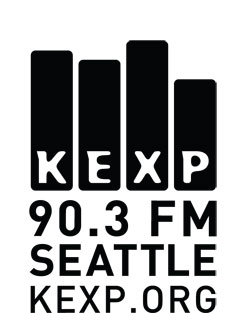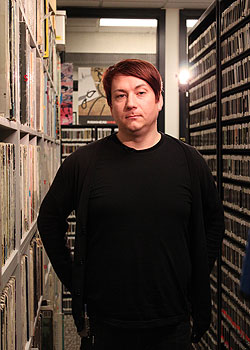SEATTLE – March 16, 2011 – Music matters at the popular Seattle radio station KEXP 90.3 FM, and with the help of Microsoft technology, the music the station plays can now matter to a lot more people.
Microsoft and KEXP have teamed up to give the station a “technological makeover” from the inside out, employing software and services such as Windows Azure and Microsoft Dynamics to streamline everything from the way employees and volunteers communicate internally to the way listeners worldwide interact with music. The makeover will take place over the course of three years, though some of the improvements will launch this spring, and fans of the station will soon see changes in the way they can interact with the music the station plays and a wide-range of supporting content that has been hard to find up to now.
“We are always looking for ways to connect our listeners to music, and to artists, and to be the conduit of that we need to use a lot of key technology, especially online,” said Aaron Starkey, KEXP’s manager of online services.

Since 2003, Microsoft and its employees have donated more than $1.5 million in cash, software and volunteer time to KEXP.
At the Nonprofit Technology Conference in Washington, D.C., this week Akhtar Badshah, Microsoft’s senior director of Global Community Affairs, is showcasing the KEXP makeover, and is discussing how other nonpofits can take a similar approach to revolutionizing their organizations. Microsoft donates on average more than $1 million a day in software to nonprofit organizations around the world, he said.
KEXP’s willingness to experiment made the station a natural partner, he said. The station’s use of Microsoft technology ranging from Windows Azure to SharePoint Online to Microsoft Dynamics CRM helps the company show how it can help nonprofits in a holistic way.
“Our partnership with the radio station can become a model for us that can be shared across a number of different organizations,” he said.
This week Badshah will be in front of a number of nonprofit organizations, using KEXP as an example of the next generation of technology possibilities and how everything from museums to performing arts to disaster relief organizations can use Microsoft technology to not just improve efficiency but to “really transform their organization and take it to the next level.”
“By providing KEXP with Windows Azure and a fully innovative set of services, they can pass opportunities on to their listeners, who can then connect in a far more dynamic way with the radio station,” Badshah said.
A Virtual Treasure Chest
KEXP, which began as a 10-watt station in 1972, grew into a musical force in Seattle and then beyond with the help of a supportive membership base and Internet streaming. It was the first station in the world to offer CD-quality streaming audio on the internet 24 hours a day, seven days a week, Starkey said. KEXP now broadcasts in the Seattle area on 90.3, in New York City via 91.5, and worldwide via the web at KEXP.org.
The radio station’s colorful history and widespread support among musicians has made it a virtual treasure chest of musical media, whether it’s the music library itself or related content such as live performances, podcasts and videos, album reviews, blog posts, DJ notes and videos.
KEXP’s website allows users to listen live and to studio performances and archives of recent shows, Starkey said. Visitors also can read about artists and buy music on the site. But currently, much of the vast musical information at KEXP is compartmentalized, unconnected, or not online at all.
“Today if a DJ were going to play a CD or record, we can tell you what it is we’re playing, but we have a hard time telling you that there is all of this related content – we also have 85 related photos, 15 videos, some blog entries, an album review, and some in-studio sessions,” Starkey said.
That’s about to change, thanks to a metadata “warehouse” that KEXP has built with Microsoft. The warehouse stores all of those bits of related data in the cloud and will soon put them at listeners’ fingertips.
Standing in the radio station’s vast music library, Starkey pulls an album from the shelf. On the front cover of this and many other albums and CDs are handwritten notes going back and forth between DJs about what songs are awesome, or “not awesome” – some of the album note conversations span 15 years, Starkey said.
“That’s the sort of information we’d like to be able to make available to anybody that’s listening,” Starkey said. “It’s taking this type of information that connects our listeners to the artist, and to the DJ, and putting it online connects our listeners to both the artists and the DJs.”
Beginning this spring, listeners can go online (as more and more listeners are wont to do) to – using the metadata system – hunt for nuggets on bands they hear played on the station. The new system also will soon enable a more social experience for listeners, letting them keep track of favorite songs or post favorite content on Facebook, said Eric Schmidt, senior director of Developer and Platform Evangelism at Microsoft.
Few understand this relationship better than Schmidt, who along with being a Microsoft employee is also a longtime KEXP volunteer and weekend DJ.
When he first started helping at the station in 2008, Schmidt looked around and realized there was a huge technology need at the station. The opportunities for a technological makeover ranged from getting employees and volunteers on a unified, capable e-mail and instant messaging system, to larger challenges such as managing a dynamic donor and member database and a massive library of musical and musical content.

Aaron Starkey, KEXP’s manager of online services.
“The mission of KEXP is to enrich the lives of listeners through music discovery,” Schmidt said. “Anything we can do to make that faster, easier, and more enriching that’s what we want to invest in.”
Microsoft also wants has to be tied into being good stewards of the KEXP brand, driving membership, and giving. It’s one thing to say, ‘Hey, we want to help people discover music.’ But if it’s not also motivating people to give, then the model doesn’t work.”
Since 2003 through the company’s internal Giving Campaign, Microsoft and its employees have donated more than $1.5 million in cash, software and volunteer time to KEXP, Schmidt said.
Ultimately, Schmidt hopes that enriching and building on the interactive experience will inspire KEXP listeners to open their wallets and give back to the station, which depends on donations to run. In addition, by enabling more listeners to become better evangelists for the station, he hopes that the worldwide KEXP community will continue to grow and discover even more music.
For Schmidt and other employees who have worked on the project, it’s been a dual labor of love – a chance to help revolutionize the radio station he believes in with the technological solutions he passionately promotes.
“I spend weekends, late nights, plane rides, every free moment to bang out code or work on some architecture issues – but like anything substantial it’s about teamwork and we getting lots of support from around the company,” Schmidt said.
Once the new platform is completed, KEXP will again be at the forefront of leveraging technology as a means to tackle the next generation of music discovery experiences. They may even invent that experience, Schmidt said.
Spinning Music for the Globe
As people continue to migrate from listening on the radio to online streaming, KEXP must focus not only on those within range of its radio tower, but those far beyond, Starkey said. “Driveway moments” where listeners take an extra spin around the block to finish listening to a song are no longer limited to the Seattle area, he said.
“We get e-mails from people that may be having their ‘driveway moment’ on top of a mountain in South America, and they’re streaming us on their phone, and they just e-mailed us a request, and it’s awesome and they’re watching the sunrise. Or they’re driving across Northern Ireland. Or they’re sitting at their desk in Florida,” Starkey said. “We want to serve everybody.”
Technology is the tool that can make that happen, he said. It allows for people to learn something they didn’t know before, or see something they hadn’t seen, or fall in love with a piece of music. A good DJ will take listeners on a journey from something that’s familiar that they like, say The Pixies, to a similar band from Tacoma, Wash., that they might not have heard of, Starkey said.
Like the journey of a good DJ, a powerful website makes the search for information seamless and immersive.
“You’re listening to the song on the radio or on your phone, and you go to explore more about the artist and you get lost in it – lost in the content and the connections,” Starkey said. “I think that if we can tighten the circle between the artist, the station, and the listener through the media I think we’ll have done something pretty cool.”
He added: “We don’t make members out of nothing, we make members out of people who have connected to KEXP, and technology brings them closer.”




